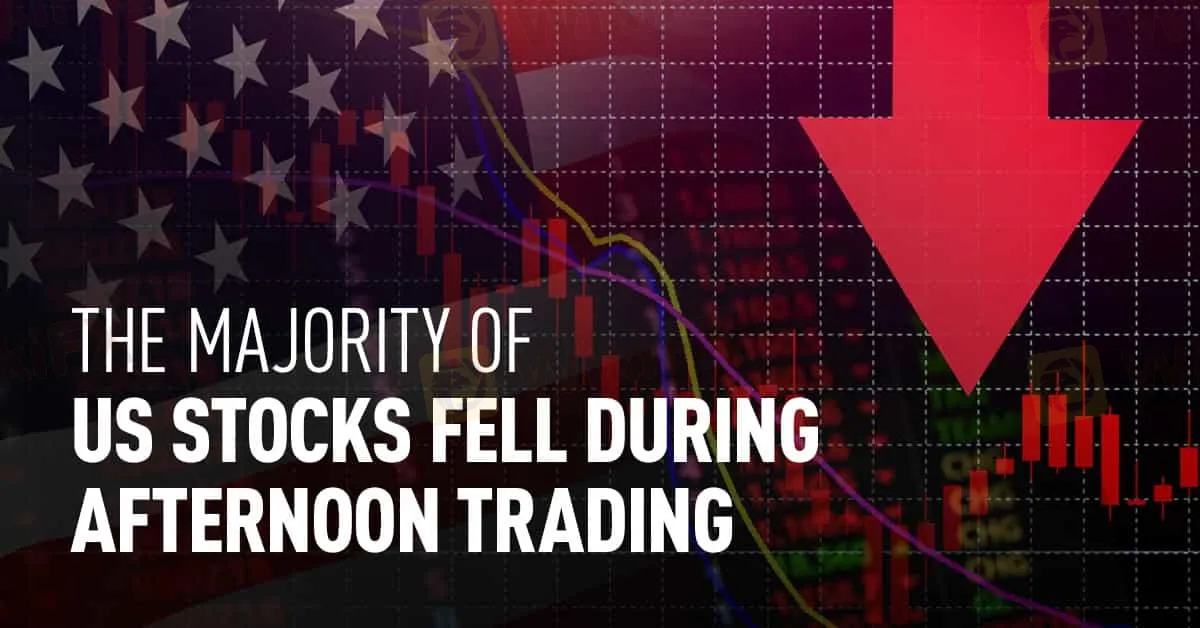简体中文
繁體中文
English
Pусский
日本語
ภาษาไทย
Tiếng Việt
Bahasa Indonesia
Español
हिन्दी
Filippiiniläinen
Français
Deutsch
Português
Türkçe
한국어
العربية
THE MAJORITY OF US STOCKS FELL DURING AFTERNOON TRADING.
Abstract:Stock prices dropped over most of Friday's session, and more selling has occurred since. Given that the major averages have continued to fall into negative territory, it is anticipated that the Nasdaq and the S&P 500 will close lower for the third day in a row.

Stock prices dropped over most of Friday's session, and more selling has occurred since. Given that the major averages have continued to fall into negative territory, it is anticipated that the Nasdaq and the S&P 500 will close lower for the third day in a row.
The major averages are still down even if they have bounced back from their lowest positions in the last trading session. The Dow, which is currently at 38,712.58, has dropped by 193.08 points, or 0.5 percent, on the Nasdaq, 30.91 points, or 0.6 percent, and the S&P 500, by 135.86 points, or 0.8 percent.
Direction of interest rates ahead of the Federal Reserve's monetary policy meeting the following week can be partly blamed for Wall Street's weakness.
Though it is widely expected that the Fed will keep interest rates at their present levels, traders will be scanning future rates.
The likelihood that the Fed will lower interest rates for the first time in June has decreased due to more recent, higher-than-expected inflation data.
The likelihood that the Fed will keep interest rates steady at its June meeting has increased from 25% to 41.6%, citing the CME Group's FedWatch Tool.
Regarding the American economy, a report issued by the Labor Department revealed that import prices rose in February in accordance with projections made by analysts.
According to data from the Labor Department, import prices increased by 0.3 percent in February following a 0.8 percent increase in January. The increase was expected.
Report stated that export prices increased by 0.8 percent in February after a revised higher 0.9 percent gain in January.
The initial figure for the prior month indicated an increase of 0.8 percent, although economists had predicted an increase of 0.2 percent.
The Federal Reserve also published a report that indicated that U.S. industrial production increased somewhat in February, with manufacturing and mining output rebounding from January's decreases caused by inclement weather.
According to the Fed, industrial production decreased by a downwardly revised 0.5 percent in January but increased by 0.1 percent in February.
In contrast to the 0.1 percent decline that was initially reported for the prior month, economists had predicted that industrial production would remain steady.
University of Michigan indicated a minor decline in U.S. consumer confidence in March.
According to the survey, the consumer sentiment index decreased slightly in March, from 76.9 in February to 76.5. The index was projected to remain steady by economists.
The long-term and year-ahead inflation forecasts were 3.0 percent and 2.9 percent, respectively, unchanged from the previous month.
A survey by the Federal Reserve Bank of New York also revealed that the manufacturing activity in New York shrank in March at a noticeably faster pace.
INDUSTRY NEWS
Even while the larger markets are exhibiting weakness, the majority of the important sectors are only seeing slight daily movements.
Despite completing the previous session at its strongest closing level in over a month, the Dow Jones U.S. Software Index fell by 2.8 percent, indicating that software equities are still seeing significant pressure.
After posting better-than-expected fiscal first-quarter results but giving poor revenue outlook for the current quarter, Adobe (ADBE) has led the industry lower, plunging 14.3 percent.
While there is still some strength in home equities, retail stocks are seeing significant decline today.
DIFFERENT MARKETS
Asia-Pacific stock markets saw a majority of their moves lower on Friday in international trading. China's Shanghai Composite Index defied the downward trend and increased by 0.5 percent, but Hong Kong's Hang Seng Index plummeted by 1.4 percent and Japan's Nikkei 225 Index sank by 0.3 percent.
In the meantime, the day's performance of the main European markets was drab. The German DAX Index and the French CAC 40 Index closed the day essentially unchanged, although the FTSE 100 Index in the United Kingdom fell by 0.2 percent.
Treasury bonds are slightly weakening in the bond market, continuing the week-long downward trend. The benchmark ten-year note's yield, which is inversely correlated with price, then rises by 1.0 basis points to 4.308 percent.

Disclaimer:
The views in this article only represent the author's personal views, and do not constitute investment advice on this platform. This platform does not guarantee the accuracy, completeness and timeliness of the information in the article, and will not be liable for any loss caused by the use of or reliance on the information in the article.
Read more

5 Reasons Why Traders Are Losing Trust in Headway Broker
Signs that make you afraid of being scammed. As a result, you end your cooperation with any broker that seems suspicious. This is exact reason why traders are keeping their distance from Headway. But what are the major concerns? You should know them. We’ve explained these warning signs in the article below. Keep reading to stay alert and informed.

Weekend Gap in Forex: What It Is & How to Handle It?
When the market closes on Friday and reopens on Monday morning. It is called a "weekend gap" can happen. In this article, you will read What a weekend gap is, Why it happens and how to handle weekend gaps?

41 More Victims Reported in a RM10-Million Forex Scam in Malaysia
A massive forex investment scam has defrauded Malaysians of over RM10 million. Now, 41 new victims have come forward to file police reports, revealing an additional RM6.1 million in losses.

Hantec Financial: A Closer Look at Its Licenses
When selecting a broker, understanding its regulatory standing is an important part of assessing overall reliability. For traders seeking to protect their capital, ensuring that a platform operates under recognised and stringent oversight can make all the difference. Keep reading to learn more about Hantec Financial and its licenses.
WikiFX Broker
Latest News
U.S. doubles down on Aug. 1 tariffs deadline as EU battles for a deal
Buffett and Thorp’s Secret Options Strategies
Sharing Trading Mistakes and Growth
Trading Market Profile: A Clear and Practical Guide
Eyeing Significant Returns from Forex Investments? Be Updated with These Charts
Mastering Deriv Trading: Strategies and Insights for Successful Deriv Traders
Brexit made businesses abandon the UK. Trump's hefty EU tariffs could bring them back
Can We Just Skip To Next Week
Insider report: These stocks had the biggest sales by executives in the past week
How to Use a Free Forex Trading Bot for Big Profit
Currency Calculator


